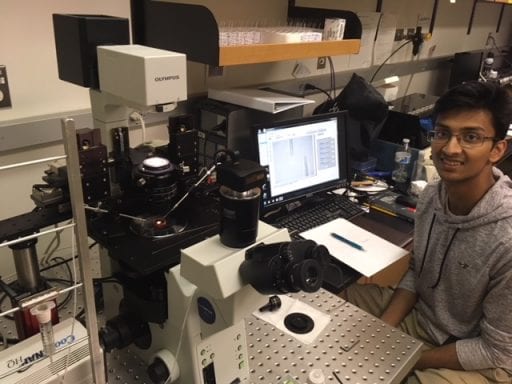Micromanipulation of micropipettes for force measurement is a novel technique
- The last micromanipulation of micropipettes force measurement experimental setup was engineered and built in 1998 by now Prof. Mike Poirier to isolate and measure the force response of mitotic chromosomes from live Newt cells.
- As a Postdoc I adapted this technique to isolate a single nucleus from a living cell and measure force response via whole nucleus extension at physiological speeds.
- I am proud to present our “proof of concept” Micromanipulation Microscope 1.5. With the help and dedication of Vis, an undergrad researcher, we have built the first micromanipulation force measurement microscope in two decades (1998 to 2018)!!! This instrument was built from an old IX-81 base into a fully functioning unit. Upon receiving a professor position I will build a version 2.0 micromanipulation microscope with advanced microscope imaging capabilities beyond current builds which are outfitted with phase imaging and widefield fluorescence.
- Acknowledgements: We would like to thank the NIH NRSA Postdoctoral Fellowship and the NIH K99 Pathway to Independence Award for funding the building of this microscope. My mentor Prof. Marko was an invaluable resource and provided many expensive spare parts necessary to build this instrument. Thank you to Vis for doing the software upgrading, coding, integrating hardware and software, and general engineering that was essential to the functionality of this instrument.
Below are images of the instrument construction and videos of it showing full functionality
Micropipette force pre-calibration – A micropipette with a known bending stiffness (bottom) is pushed against a micropipette with an unknown bending stiffness to determine bending stiffness. The size of the micropipette opening and the force are maintained in a narrow window and correlate, the opening is ~3 um and 2 nN/um bending constant.
Single nucleus isolation from a living cell in minutes – The top micropipette sprays dilute detergent on to a MEF V-/- living cell in culture to open the cell. The other micropipette grabs the nucleus and separates it from the cell. This process is fast (1-2 minutes) and does not subject the nucleus to harsh continual detergent and mechanical abuse that occurs normally during bulk nucleus isolation.
Micromanipulation force extension measurement of a single isolated nucleus – The “pull” micropipette (right) extends the nucleus while the “force’ micropipette measures force via deflection multiplied by the premeasured bending constant.





